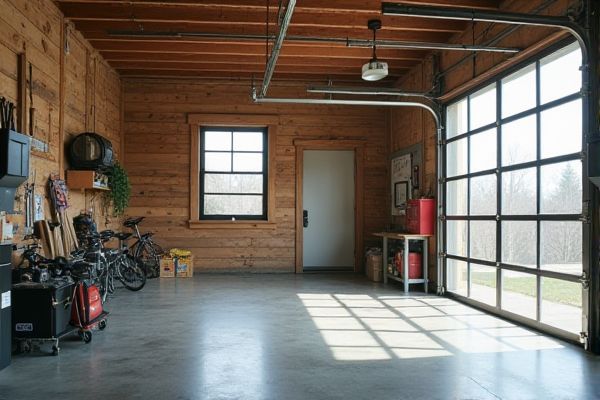
Windowless garage designs offer enhanced security and improved insulation by minimizing external vulnerabilities, while windowed garages provide natural light and ventilation that can reduce energy costs and create a more inviting workspace. Discover which garage style best suits your needs and preferences as you explore the rest of the article.
Table of Comparison
| Feature | Windowless Garage | Windowed Garage |
|---|---|---|
| Natural Light | None, relies on artificial lighting | Ample natural light, reduces electricity use |
| Security | Higher security, fewer entry points | Potential vulnerability due to windows |
| Ventilation | Requires mechanical ventilation | Enhanced airflow and natural ventilation |
| Privacy | Maximum privacy, no outside view | Reduced privacy, visibility inside |
| Cost | Lower initial construction cost | Higher cost due to window installation |
| Aesthetics | Plain exterior, utilitarian design | Improved appearance, can complement home design |
| Maintenance | Less maintenance, no window repairs | Higher maintenance due to glass cleaning and repairs |
Introduction to Garage Design: Windowless vs. Windowed
Windowless garage designs prioritize security and climate control by eliminating exterior openings, reducing heat loss and potential break-ins. Windowed garages enhance natural lighting and ventilation, improving visibility and airflow, which can reduce electrical lighting costs and moisture buildup. Choosing between these designs depends on factors like privacy needs, energy efficiency goals, and the desired balance between functionality and aesthetics in residential architecture.
Aesthetic Appeal: Comparing Visual Impact
Windowless garages offer a sleek, minimalist appearance that can enhance modern architectural styles by providing uninterrupted wall surfaces ideal for clean lines and uniform color schemes. In contrast, windowed garages introduce natural light and visual interest, creating a more inviting and dynamic facade that complements traditional and transitional home designs. The choice between windowless and windowed garages significantly influences the overall curb appeal and architectural harmony of residential properties.
Natural Light Access and Brightness
Windowed garage designs maximize natural light access, enhancing brightness and reducing reliance on artificial lighting during daytime. In contrast, windowless garages rely heavily on electric lighting, which can increase energy consumption and result in dimmer, less inviting interiors. Incorporating strategically placed windows not only improves visibility but also creates a more welcoming and functional workspace.
Ventilation and Airflow Considerations
Windowless garage designs rely heavily on mechanical ventilation systems such as exhaust fans and air vents to maintain proper airflow and prevent buildup of fumes and humidity. In contrast, windowed garages benefit from natural ventilation through operable windows, which enhance airflow and reduce the need for powered ventilation. Proper ventilation in both designs is critical for controlling moisture, preventing mold growth, and ensuring safe air quality, especially when garages house vehicles or combustion equipment.
Energy Efficiency and Temperature Control
Windowless garages offer superior energy efficiency by minimizing heat loss and preventing unwanted drafts, resulting in more stable indoor temperatures year-round. Without windows, insulation remains uninterrupted, enhancing temperature control and reducing heating and cooling costs. Conversely, windowed garages can introduce heat gain during summer and heat loss in winter, making it harder to maintain consistent energy-efficient conditions.
Privacy and Security Factors
Windowless garages offer enhanced privacy by eliminating visibility from the outside, reducing the risk of theft or vandalism. Without windows, these garages provide a solid barrier against potential intruders and protect stored valuables from prying eyes. In contrast, windowed garages can compromise security but allow natural light and ventilation, requiring additional measures like security film or bars to maintain privacy and safety.
Storage and Space Utilization
Windowless garage designs maximize wall space, allowing for more versatile storage options such as shelving, cabinets, and tool racks without interruption from windows. Windowed garages, while offering natural light, often limit available wall space, potentially reducing storage capacity and requiring more strategic space utilization. Your choice depends on whether you prioritize increased storage efficiency or enhanced lighting and aesthetics in the garage.
Cost Implications of Windowed vs. Windowless Garages
Windowless garages generally cost less to build and maintain due to fewer materials and reduced labor requirements compared to windowed garages, which require additional framing, glass installation, and insulation. Windowed garages can increase upfront expenses and ongoing energy costs but offer improved natural light and ventilation, potentially reducing the need for artificial lighting. Your decision should weigh the trade-off between initial investment and long-term utility benefits based on your budget and usage needs.
Maintenance and Upkeep Challenges
Windowless garage designs typically offer reduced maintenance needs by minimizing potential issues such as window frame rot, glass breakage, and leak repairs, which can be common in windowed garages. However, windowed garages may require more frequent upkeep due to cleaning, sealing, and addressing moisture or condensation problems that affect windows and surrounding structures. Your choice should consider the balance between lower maintenance demands and the benefits of natural light and ventilation provided by windowed garages.
Choosing the Right Design for Your Needs
Windowless garage designs offer enhanced security and improved insulation, making them ideal for storage or workshop spaces where natural light is unnecessary. In contrast, windowed garages provide better ventilation and natural illumination, which can improve comfort and reduce energy costs if you use your garage as a living or working area. Your choice depends on whether you prioritize security and climate control or prefer brightness and airflow in your garage environment.
 homyna.com
homyna.com